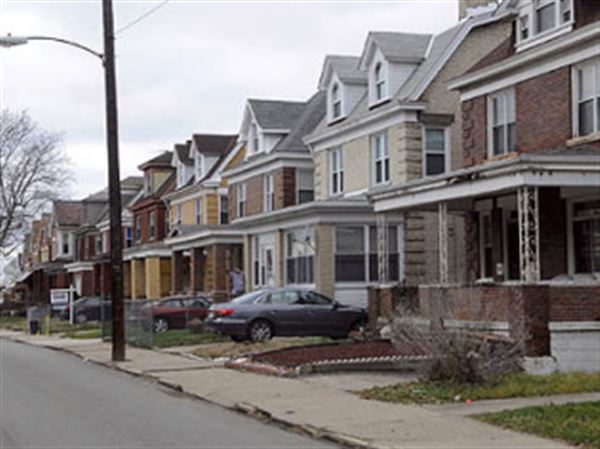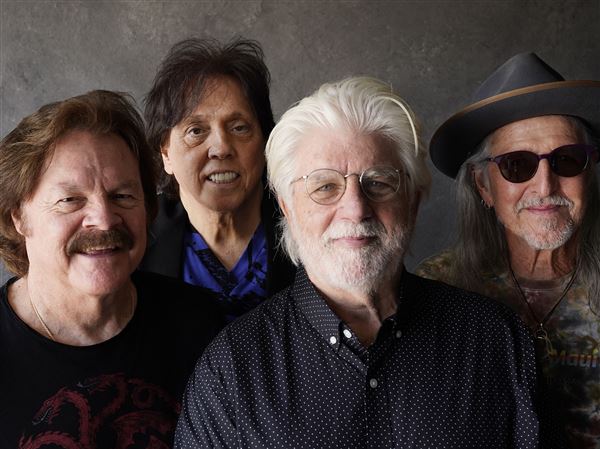The god of great good fortune smiled on Pittsburgh the day Robert Regan came to town and fell in love with the city steps.
Natives may take them for granted, but Regan, a visiting research professor at the University of Pittsburgh and a software mapping consultant, recognized them for the hidden treasures they are. Not long after discovering them on his early-morning bike rides, he decided to map them.
"And that decision was followed by about eight years of procrastination," Regan said. Then about 5:30 one morning, he was bicycling across the Birmingham Bridge, looked over at the South Side and saw three rows of lights going straight up the hill. He knew they had to be three flights of steps, and he knew that something about that scene was spurring him to action.
"I biked home [to Squirrel Hill], woke my wife and said, 'I'm taking two or three months off to map the steps.' And that's when I did it."
Five years, 712 sets of steps and 44,645 treads later, Regan is the author of "The Steps of Pittsburgh: Portrait of a City," just published by The Local History Co., the Shadyside-based history and heritage publisher. Illustrated by Tim Fabian's photographs, the book is both a history of the steps and a guide to their use. Think of it as a necessary companion to the city's other guides, one that explores and celebrates the vertical connections between neighborhoods.
Built to help Pittsburghers navigate steep terrain quickly in the days before the automobile, the city steps survive and thrive. Children use them to get to school, grandmothers to pick up a quart of milk at the corner store, neighbors to visit neighbors. On the steepest streets, the steps double as sidewalks. They also offer some of the best vantage points from which to photograph the city or simply witness how it rises and falls and sweeps from densely built row house neighborhoods to Downtown skyscrapers. Rare is the city that can encompass so much of its history in a single frame.

Robert Regan's book, "The Steps of Pittsburgh," maps all steps in the city with photographs by Tim Fabian.
Click photo for larger image.
To buy the book

Osgood and Marsonia Streets, Fineview, North Side.
Click photo for larger image.
It was partly the steps' history that captivated Regan.
"They are probably the first mass transportation system in Pittsburgh," he said. "I picture people spending 12 hours in the mill and walking back up at the end of the day."
Then there's the humor angle.
"I laugh at times, thinking of motorists looking at a map, making a turn and they're faced with a flight of steps."
Yep, Pittsburgh is a trickster city. Some of its hillside streets that appear on maps are nothing but "paper streets," too steep to be roads. With street signs at their tops and bottoms, some of the city's steps are better identified than many of Western Pennsylvania's real streets.
Locals know where the steps in their neighborhoods are, but for the rest of us they can be hard to find, especially when obscured by leafed-out trees and shrubs.
No more: In the summer of 1999, Regan completed the first full survey of the city steps, using a combination of computer mapping techniques and good old-fashioned footwork. Armed with a database of streets from the city's Department of Engineering and Construction, he logged 1,800 miles, riding every city street and climbing every step.
The result was a map, completed in 2002 and reproduced in the book, that shows the location of each of the 712 sets of wooden or concrete steps. Of those, a surprisingly high number -- 334 -- are paper streets, and four of those are simply paved paths with no steps at all. Regan produced five other maps showing the locations of steps as their numbers increased between 1884 and 2002.
He also designed maps for each of the book's six walking tours -- in Fineview, Lawrenceville, Oakland and the West End and two on the South Side -- which will introduce many readers to remote and unfamiliar terrain and stunning views.
Regan found that the city's database had construction dates for 501 sets of steps built between 1911 and 2000. The 204 sets built in the 1940s were the most constructed in any one decade, followed by 137 sets built in the 1950s.
Ray Avenue in Brookline has the highest number of treads per flight of steps -- 378. Taking them all in one gulp would be like climbing the steps of a 20-story building. The next longest is Jacob Street in Brookline (364 treads), followed by 57th Street between Lawrenceville and Stanton Heights (345 treads); Rising Main Way in Fineview (331 treads) and Yard Way on the South Side (317 treads).
But even those daunting climbs can't compare with the old Indian Trail steps, which Regan calls "the most spectacular set of city steps anywhere on the planet." Long gone, they ran up the side of Mount Washington for about half a mile, from Carson Street near the Fort Pitt Tunnels to the intersection of Shaler Street and Grandview Avenue.
They appear in one of the book's many historic photographs, some of which were taken to document their construction.
In addition to the views they afford, the sculptural, zigzagging effect of the steps themselves can be astonishing, as Fabian's black-and-white photographs illustrate. About 60 are included.
Some were shot with an Ansco Pix Panorama, a cheap little plastic camera (Fabian found his for $2 at a flea market) that uses 35mm film. It has a fixed, relatively wide lens -- 28mm -- but the panoramic effect is produced by the template within the camera that masks the top and bottom of the film. It was the Pix that produced the letterbox-format photographs throughout the book.
Fabian used fast film -- Ilford Delta 3200 -- because the camera has only one shutter speed. Because he liked its grainy quality, he continued to use the film even when he switched to his Nikon for most of the book's photography.
Fabian strove to capture a pictorialist feel as well as the city's timeless quality.
"For me it became a way to look at the city that was unique," he said. "It became my take on the fabric of the city. Instead of showing just the pretty buildings Downtown, you can really show a way of life."
Regan and Fabian also include a chapter on how Pittsburghers use the steps -- how children play on them, adults climb them for exercise and bicycle cops sometimes do what needs to be done and take the steps on the fly.
The authors hope the book will inspire the city and its citizens to care for and preserve their steps, the largest collection of any city in the country. Some of the steps, which require continual vigilance, are sadly and badly in need of repair or replacement (not to mention trash cleanup). Last year, the city planned to replace three sets of steps, but the budget crisis allowed for only one.
Regan thinks the steps should be celebrated as a tourist attraction, and his enthusiasm inspired the South Side Slopes Neighborhood Association to launch the first "Step Trek," a sort of vertical Great Race with no winners and losers, in 2000.
One of the most appealing aspects of this city is that its topography creates so many hidden, rustic enclaves with dazzling vistas. There are pockets of Pittsburgh most of us have never seen, and "The Steps of Pittsburgh" is an excellent way to find them.

Robert Regan's book, "The Steps of Pittsburgh," maps all steps in the city, including those at Frazier and Romeo streets, Oakland.
Click photo for larger image.
First Published: March 16, 2004, 5:00 a.m.
















